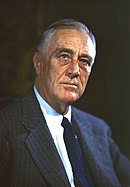全国劳资关系法
1935年全国劳资关系法(National Labor Relations Act of 1935,又称瓦格纳法,Wagner Act;国家劳工关系法)是美国制定的一部有关劳动关系的法规,它保障私营部门的雇员组织工会、与公司进行集体协商和采取罢工等集体行动的权利[1]。该法案由参议员罗伯特·F·瓦格纳草拟,由第74届美国国会通过,并由美国总统富兰克林·德拉诺·罗斯福签署成为法律。
全国劳资关系法旨在通过促进工会和雇主之间的集体协商,改善雇主和雇员之间谈判不平等的状况。全国劳资关系委员会就是依据该法成立,全国劳动关系委员会专门负责起诉违反劳动法的主体。它还制定了有关集体协商的各种规则,并界定哪些行为属于不当劳动行为,包括雇主干涉工会的成立和运作。该法不适用于某些行业的职工,例如主管、农业雇员、家政工人、政府雇员和独立承包商。
全国劳资关系法遭到保守派和共和党的强烈反对,不过在国家劳资关系委员会诉琼斯和劳克林钢铁公司一案中,美国最高法院选择支持全国劳资关系法。1947年通过的塔夫特-哈特莱法案对全国劳资关系法有所更正。
注释
- ^ Nelson, Joyce. The Colonized Eye: Rethinking the Grierson Legend. Toronto: Between the Lines. 1988: 25, 88.
参考文献
- 书籍
- Atleson, James B. Values and Assumptions in American Labor Law Pbk. Amherst, Mass.: University of Massachusetts Press. 1983. ISBN 978-0-585-25833-1.
- Cortner, Richard C. The Wagner Act Cases. Knoxville: Univ. of Tenn. Press. 1964. LCCN 64016880.
- Dannin, Ellen. Taking Back the Workers' Law: How to Fight the Assault on Labor Rights. Ithaca, N.Y.: ILR Press/Cornell University Press. 2006. ISBN 978-0-8014-4438-8.
- Gregory, Charles O. Labor and the Law 2d rev. ed., with 1961 Supplement. New York: Norton. 1961. LCCN 61007636.
- Kennedy, David M. Freedom from Fear: The American People in Depression and War, 1929-1945. Oxford University Press. 1999. ISBN 978-0195038347.
- Morris, Charles J. The Blue Eagle at Work: Reclaiming Democratic Rights in the American Workplace. Ithaca, N.Y.: Cornell University Press. 2004. ISBN 978-0-8014-4317-6.
- Schlesinger, Arthur M. The Coming of the New Deal: 1933–1935 1. Mariner books. Boston: Houghton Mifflin. c. 2003. ISBN 978-0-618-34086-6.
- 文章
- F. L. B., Jr. Reinstatement with Back Pay under the Wagner Act. U. Pa. L. Rev. & Amer. L. Reg. Mar 1941, 89 (5): 648–60. JSTOR 3309199. doi:10.2307/3309199.
- Keyserling, Leon H. The Wagner Act: Its Origin and Current Significance. Geo. Wash. L. Rev. 1960–1961, 29: 199.
- Klare, Karl E. Judicial Deradicalization of the Wagner Act and the Origins of Modern Legal Consciousness, 1937–1941. Minn. L. Rev. 1977–1978, 62: 265.
- Lynd, Staughton. Communal Rights. Tex. L. Rev. 1984, 62 (1417): 1430–35.
- Mikva, A. J. The Changing Role of the Wagner Act in the American Labor Movement. Stan. L. Rev. 1986, 38 (4): 1123–40. JSTOR 1228578. doi:10.2307/1228578.
- Nathanson, N.L.; Lyons, E. Judicial Review of the National Labor Board. Ill. L. Rev. 1938–1939, 33: 749.
- Effect on the A. F. of L. -C. I. O. Controversy of the Determination of Appropriate Bargaining Units under the National Labor Relations Act. Yale L.J. 1935–1958, 47 (1): 122–124. JSTOR 791821. doi:10.2307/791821.
- The Proposed Amendments to the Wagner Act. Harv. L. Rev. 1938–1939, 52 (6): 970–983. JSTOR 1334189. doi:10.2307/1334189.
- Pope, J. G. How American Workers Lost the Right to Strike, and Other Tales. Mich. L. Rev. 2004, 103 (3): 518–53 [2021-01-16]. JSTOR 4141930. doi:10.2307/4141930. (原始内容存档于2021-01-21).
- Pope, Jim. Worker Lawmaking, Sit-Down Strikes, and the Shaping of American Industrial Relations, 1935–1958. Law & Hist. Rev. 2006, 24 (1): 45–113. JSTOR 27641352. doi:10.1017/S0738248000002273.
- Scheunemann, Edward. The National Labor Relations Act Versus the Courts, 11 Rocky Mountain L. Rev. 135 (1939)
- Warm, J. Louis. A Study of the Judicial Attitude Toward Trade Unions and Labor Legislation. Minn. L. Rev. 1938–1939, 23: 256.
- Woods, Warren; Wheatley, Altha C. The Wagner Act Decision – A Charter of Liberty for Labor?. Geo. Wash. L. Rev. 1936–1937, 5: 846.
参见
- 布雷迪诉马里兰案
- 詹克斯诉美国案
- 吉廖诉美国案
- 康尼克诉汤普森诉案
- 布雷迪证据开示
外部链接
- USC §§151-169, Labor-Management Relations (页面存档备份,存于互联网档案馆) at the Legal Information Institute
- National Labor Relations Act
- National Labor Relations Board
| ||||||||||||||||||||||||||||||||||||||||||||||||||||||||
| |||||||||||||||||||||||||||
| ||||||||||||
Text is available under the CC BY-SA 4.0 license; additional terms may apply.
Images, videos and audio are available under their respective licenses.

